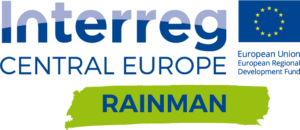Kész cselekedni
ÖNKORMÁNYZATKÉNT
a tartalom csak angol nyelven érhető el

Heavy rainfall events can lead to high losses and damages, if those who are affected are not prepared. In this section you will find information on how to take action as a municipality and prevent damages from heavy rainfall events in your community. You will be directed to the tools in the Toolbox that are especially relevant for you.
KEY FACTS ABOUT HEAVY RAIN EVENTS
- Heavy rain events often occur in connection with severe summer thunderstorms.
- They lead to local flooding, e.g. due to uncontrolled surface runoff in the area, and sometimes cause extreme damage.
- Almost any location can be affected, even if it is not located close to a water body.
- The advance warning time is extremely short and the exact location is hardly predictable, especially since the location of occurrence can be very limited.
- Experts expect heavy rain events to occur more frequently in the future.

Picture: Instytut Meteorologii i Gospodarki Wodnej – Państwowy Instytut Badawczy, Poland
What is to be done?

Assessment and Mapping
Firstly, get to know the risks!
For municipalities, successful heavy rain risk management starts with assessment and mapping in order to identify, locate and evaluate potential heavy rain hazards and risks. Local authorities need to know where the water from heavy rain events accumulates and where it can pose hazards and risks to people, infrastructure and property on its way to the next river or lake. Mapping heavy rain hazards and risks helps to communicate the topic, for example to citizens or emergency management units in order to properly prepare them for the next heavy rain event.
Start with the tool ASSESSMENT and MAPPING for finding suitable methods for your municipality.

Risk Communication
Communicate the risks!
Communication of risks and thereby raising awareness are important precautionary components of an integrated heavy rain risk management. Citizens might not be aware of heavy rain risks at all. Therefore it is essential that municpalities communicate the risks of heavy rain and possibilities and limitations of measures in an understandable way and thus enable those affected to understand them properly. Then citizens can act accordingly and take suitable risk reduction measures.
Learn more about how to communicate risks to the people living in your community in our tool RISK COMMUNICATION.

Risk Reduction Measures
Take precautions to reduce the risks!
Hazard and risk information about possible flow paths, flooded areas, water depths, flow velocities and temporal development of the flooding from specific heavy rain scenarios needs to be available. These mapped hazards and the resulting considerations regarding risk hot spots and sensitive infrastructure help to identify regions or installations where risk mitigation measures might help to avoid or reduce possible damages from existing or future receptors. Stakeholders are involved and ready to help acting, depending on their role.
There are different ways on how to prioritize your risk reduction measures. For example you might want to …
- …reduce the highest risks first,
- …implement the measures with the highest risk reduction potential first,
- …implement the measures with the best stakeholder acceptance first,
- …implement the cheapest measures first,
- …implement the measures with the best cost-benefit ratio first.
Tool RISK REDUCTION MEASURES provides many approaches to reducing the risks of a heavy rain event. Hereby, different strategies for risk reduction should be combined while taking different fields of action into account.
Heavy rain risk management is a cross-sectional task
Involve different stakeholders in the process
It is essential to involve different stakeholders in your process to reduce the risks of heavy rain events for your community.
Explore the picture for some indication on whom to involve.
Link heavy rain risk management with other cross-sectional topics
In municipalities the need to cooperate between fields of actions is apparent and is already evident from the picture above. It is wise to exploit the synergies between different sectors and be aware of the conflicts that might arise.
There are two major other cross-sectional topics, which are closely related to heavy rain risk management:
As far as possible, damage caused by ALL types of floods should be avoided or reduced. River floods and related risks can be modelled assessed rather well. In Europe, flood hazard and risk maps are developed for areas along rivers where a flood risk exists. The maps are updated in intervals, and used by authorities for the planning of measures and for information of residents. For floods caused by heavy rain events, which can cause damage far away from water bodies, the assessment of potential flood events and the existing risk is more complex. Nevertheless, it is important that, in addition to the hazard and risk maps for river floods, hazard and risk maps for floods caused by heavy rain are also produced in the future.
Please note: All EU Member State countries have already published risk assessments and maps for river flooding and e.g. coastal flooding. It is important to notice that the characteristics of heavy rain flooding are different:
- in river (torrential and coastal) flooding, water levels in the river bed increase and water coming from the river floods regions adjacent to it.
- In heavy rain flooding, the rain water hitting the terrain surface cannot infiltrate completely into the soil or into sewage systems and thus runs down the slopes on the way to the next receiving river, lake or to the next terrain depression, which fills up. So the heavy rain flood hazard is independent from a major river.
It is important to account for both characteristics of flooding in flood risk management processes in order to effectively prevent damages. Management strategies shall integrate different sectors and different levels from municipality to Member State. Therefore, the RAINMAN partners put their recommendations and experiences together in a policy paper. The paper contains conclusions regarding the integration of pluvial flood risk management in flood risk management plans according the EU Floods Directive. These conclusions were presented in 2019 to the EU Working Group Floods, a consortium of water management stakeholders from Member States and European Commission, who support the implementation of the Floods Directive and provide a platform for a Europe-wide exchange on flood risk management.
DOWNLOAD
Integrating pluvial flood risk management into flood risk management plans according to the EU Floods Directive and beyond Ι available in English
Findings and recommendations from the INTERREG Central Europe project RAINMAN, Policy paper
Download [pdf; 471 KB]
Due to climate change heavy rain events will happen more frequently and will become more intense in the future. Damages resulting from heavy rain events are very likely to increase even further. It is essential to adapt to these changes.
Already today, heavy rain risk management is part of comprehensive local climate change adaptation strategies. For politicians, decision makers and the public an integrated consideration of climate change adaptation will become increasingly important. Heavy rain risk management is an important link between climate change adaptation and flood risk management.
WHERE DO I GET FURTHER INFORMATION?
Let the RAINMAN experience guide you...
In RAINMAN, different methods and approaches to assessing and mapping heavy rain risks, different strategies for risk reduction and risk communication were tested in different landscapes (from flatlands to mountains) and area types (from urban to rural areas or agricultural land). In short factsheets the essential facts, results and lessons-learned were summarised.
Get an overview on all OUR STORIES.

